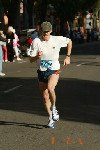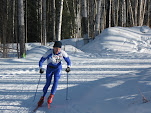Seeking Heat as Subarctic Marathon Runner
Despite some early October snow, the training went exceedingly well for several weeks. I was getting in my long runs of 2 to 2.5 hours every week, as well as a mid-length run of 1.5 to nearly 2. In the third week of October, I completed a challenging run of 19 miles when it was 15 degrees, and mostly dark. I felt tough and ready. But I left for Colorado the next day, and my hip started to hurt. I returned in time for Halloween dressed as an ice box. The thermometer dipped below zero on the 31st and in those crucial final weeks leading up to the marathon it hardly got above zero. The average for November was -5.1. http://climate.gi.alaska.edu/Summary/FAI.html
Some physical therapy kept the hip issues under check--the pain was there, but it was manageable. However, all my November long runs were done in sub-zero. Each in it's own way was a mini-epic.
November 7: At -5 this was my warmest long run, a 19 miler. Just a few days after returning from Colorado I came down with a skratchy throat. Nothing bad at first but after festering for a couple days it turned into the flu. After three days of bed-rest I knew I needed to get out there. Still wobbly, I ran the first 90 minutes easy, as little particles of ice floated out of the sky--it wasn't snow, too cold for that. Just moisture being squeezed out of the air. I then picked up the pace, trying to simulate marathon conditions for about 50 minutes. By the end I was hacking, delerious, and dizzy with fatigue.
November 13: -23. The plan was for a 20 miler. With a strong inversion temperatures were hovering around zero at our house, which is at about 1,200 feet. However, the roads are icy and hilly and I would have to spend the run going back and forth on about 3 miles of navigable roadway. I decided to go town to run on firmer and flatter terrain. That was my first mistake.
The thermometer at the university flashed the temperature next to the ice sculpture of a polar bear. Ice is nice. As I got ready in the car, I was missing a shirt layer, and at the last second the zipper on my old pullover parka ripped. Mistakes two and three. I patched up the parka with a safetypin and headed out. Within minutes I was freezing, so I decided to run home (about 9.5 miles away). The plan was to finish up the run on the ridge or get a new shirt and jacket and head back down. The first hour was miserable step after frozen step, but as I passed into the thermocline at about 600 feet the temperature increased substatnially. By the top of our hill I was sweating and feeling good. I arrived home about 85 mnutes, covered in frost-head to toe. That was probably mistake number 4.
Tamara thought I was just going to bail on the run, but when I told her that I just wanted to change and get a drink she exclaimed that I was crazy. Seeing how I was nearly unrecognizably frosty, she was probably right! After a few minutes of negotiating, I realized rational discussion wasn't going to happen, so I quickly changed and headed out and back to town to retrieve my car. However, as I headed down the hill I knew then that my chances for a decent marathon in a few weeks declining, just like the elevation and temperature. How can you get quality miles in conditions like this? How can you feel good about your training when your wife is freaking out? She was worried and passed me in the car when I was half way back--asked if I wanted to hop in. I refused and finished my run. I was planning for 6-8 miles of marathon pace at the end of of this effort but could only manage 7 or 7:30 pace. So I just tried to run efficiently. I completed the run in 2:40 (with a 9 minute layover at home), and the thermometer by the polar bear read -15. I reached the car and headed home. I tried to explain how I needed the long run to be ready for the marathon in three weeks, but Tamara was in tears and said that she was afraid that she'll find me dead on the roadside someday. That run was a subarctic disaster.
November 20: -16. This time I met Wayde, a good local master's runner and marathoner at the university. We immediately headed for higher ground, past Pearl Creek Elementary school and up Wolverine Road, which is a steep gravel climb. There we just climbed and climbed--while solving the world's political problems--until the roads just ended. Up at 1,200 to 1,300 feet we got some sun and warmer temperatures, about zero. Reluctantly we headed down. We hit the edge of the university at about 1:45 into the run and at -10, took a swig of nearly frozen sport drink and proceeded to run hard for about 25 minutes. My plan was marthon pace, about 6:30/mile, but we were going under that, probably closer to 6:10 or 6:15. Everything clicked, however, and we wound around the campus like a couple of snowballs on pipe cleaner legs--covered with polypropylene, lycra, and nylon of course! That was the best running I'd been able to do in a month. We finished with an easy jog of a mile, for a total of 2:20. Wayde was good company on a day that he didn't have to be there--he's not running a marathon until Boston in April. My confidence bouyed somewhat from the strong finish.
November 27: -14. It was about -30 in town, so I just resigned to a very cold run on the ridge, back and forth on the icy roads. My plan was for 12-13 miles with at least three being at race pace, but I opted for 90 minutes at an easy pace, maybe a 12 miler if you consider "effort" over miles.
December 4: -38 in Fairbanks, + 32 in Sacramento. I went to California planning on a 2:50 marathon, give or take. In spite of only averaging about 55 miles/week for the 10 or so weeks leading up to the race, my hip problems, and battling the elements in Alaska, I felt that I had a good base (e.g., a 1:19 half marathon back in July). Ironically, it felt rather cold over the first 5 or 6 miles. If there was one thing I'd change on that day, I would have worn my lycra thigh-length shorts instead of running shorts.

The marathon went exactly according to plan for 19 miles. I was right on 2:51 pace and feeling in control. But just after the 19 mile marker, my quads tightened and emptied of glycogen. Suddenly went from an average 6:32 pace to 7:20, then 7:30, and it got worse after that. Only over the last quarter mile did I realize that a sub 3:00 was in jeopardy, but by then it was too late. Despite a sprint to the finish line, encouraged by hundreds or maybe thousands of spectators, I completed the course with a 3:00:01, the 1st not to break 3!
Suddenly went from an average 6:32 pace to 7:20, then 7:30, and it got worse after that. Only over the last quarter mile did I realize that a sub 3:00 was in jeopardy, but by then it was too late. Despite a sprint to the finish line, encouraged by hundreds or maybe thousands of spectators, I completed the course with a 3:00:01, the 1st not to break 3!
Were there any lessons learned? Well I did learn some things about proper dress for sub-zero running (soon to be blogged). I also learned that if I'm going to do this again (run a marathon with much of the training in winter conditions), I'm going to invest in a treadmill.

